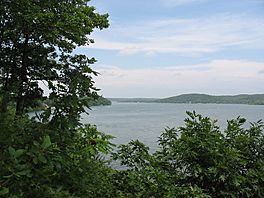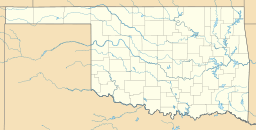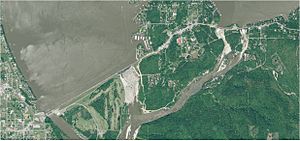Grand Lake o' the Cherokees facts for kids
Quick facts for kids Grand Lake o' the Cherokees |
|
|---|---|

View of a portion of Grand Lake near Grove, Oklahoma
|
|
| Location | Delaware / Ottawa / Mayes / Craig counties, Oklahoma, US |
| Coordinates | 36°36′43″N 94°50′29″W / 36.6119°N 94.8415°W |
| Basin countries | United States |
| Surface area | 46,500 acres (18,800 ha) |
| Surface elevation | 745 ft (227 m) |
| Settlements | Grove, Oklahoma, Disney, Oklahoma |
Grand Lake o' the Cherokees is a large lake in Northeast Oklahoma. It sits in the foothills of the Ozark Mountains. People often just call it Grand Lake. The Grand River Dam Authority (GRDA) manages the lake.
Contents
How Grand Lake Was Made
The idea for Grand Lake started with Henry Holderman. He was a citizen of the Cherokee Nation. He thought the Grand River could make electricity using water power. This is called hydroelectric power.
Building the Dam
Even before Oklahoma became a state in 1907, Henry Holderman worked to get support for his idea. The Army Corps of Engineers studied the river. They thought it was a good idea too.
- In 1935, the state of Oklahoma created the Grand River Dam Authority (GRDA). This agency would manage the project.
- Building started in 1938 on the Pensacola Dam. This was part of a government program called the Works Progress Administration. This program helped people find jobs during tough economic times.
- The dam was finished in March 1940. This created the big lake behind it.
- From 1941 to 1946, the U.S. government used the dam to make power for World War II.
- In August 1946, control of the dam went back to the GRDA.
Pensacola Dam Features
The Pensacola Dam is known as the longest multiple arch dam in the world. It has 51 arches that stretch for over a mile. A road, State Highway 28, goes across the top of the dam.
- At one end, there is a power plant with six units. These units make electricity.
- At the other end, there are 21 spillways. These are gates that can open to let water out.
- About a mile east, near the town of Disney, there are two smaller dams. They have 21 more gates.
- A huge amount of concrete was used to build the dam. Workers poured concrete 24 hours a day for 20 months.
Lake Size and Water Levels
Grand Lake is very large. It covers about 41,779 acres of water. It also has a long shoreline, stretching for 1,366 miles.
- Unlike some other lakes in Oklahoma, Grand Lake is deep and has a rocky bottom.
- The average depth of Grand Lake is about 36 feet.
- The lake's normal water level is about 745 feet above sea level.
- Sometimes, the GRDA lowers the lake level in the fall. This helps grow plants for birds that migrate.
- Grand Lake also helps control floods. It helps the Arkansas River watershed.
- Grand Lake and Lake Hudson are special. They are the only major lakes in Oklahoma where you can build homes right on the waterfront.
Water Level Concerns
People in the town of Miami and some Native American groups have concerns. They worry that raising the water level at Pensacola Dam could make flooding worse in Miami. This is because water can back up on the Neosho River, which flows through Miami.
Fun Things to Do at Grand Lake
Grand Lake is a very popular place for fun and relaxation in the Green Country area of Oklahoma.
- There are many shows and resorts around the lake.
- You can ride on the Cherokee Queen. This is a sixty-seven-foot long paddle wheel boat that has been around since the 1940s.
- Grand Lake is famous for bass fishing. It is one of the best bass fishing lakes in the United States.
- Many other types of fish live in the lake too.
- The lake also has good winds, which makes it a great spot for sailboaters.
Grand Lake in Books
- Grand Lake is mentioned in the book The Bean Trees by Barbara Kingsolver. The characters Taylor, Turtle, Estevan, and Esperanza visit the lake in the story.




